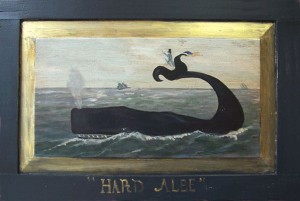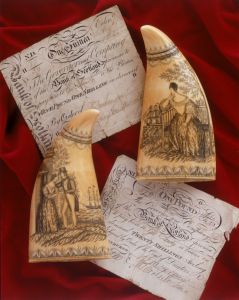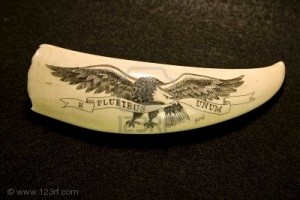By Martin Willis
For a related podcast, click here.
 For several years I assisted Chuck DeLuca from Maine with his maritime auctions. He would have such interesting pieces pass through his sales. From what I could see, there were a lot of collectors from far and wide that collect all kinds of historical maritime. The time spent helping Chuck was a great learning experience for me. On my own, I have been lucky enough to see some fabulous whale’s tooth scrimshaw work. Back in the 1980s I spent several days with Barbara Johnson in Princeton, NJ. I went over her entire collection, which was a premier selection of some of the finest pieces known. This collection was considered the foremost in the world and left a big impression on me.
For several years I assisted Chuck DeLuca from Maine with his maritime auctions. He would have such interesting pieces pass through his sales. From what I could see, there were a lot of collectors from far and wide that collect all kinds of historical maritime. The time spent helping Chuck was a great learning experience for me. On my own, I have been lucky enough to see some fabulous whale’s tooth scrimshaw work. Back in the 1980s I spent several days with Barbara Johnson in Princeton, NJ. I went over her entire collection, which was a premier selection of some of the finest pieces known. This collection was considered the foremost in the world and left a big impression on me.
There are no real reasons for whaling today, but in the earlier days, whales were harvested for numerous demands. Almost the entire whale was used  for a large variety of products and the most important of them was the oil. It was created from boiling down blubber on board, then stored in casks. It was used for lamp oil, soaps, beauty products, varnishes, lubricants and more. As sad as it seems to some, this was a part of our past.
for a large variety of products and the most important of them was the oil. It was created from boiling down blubber on board, then stored in casks. It was used for lamp oil, soaps, beauty products, varnishes, lubricants and more. As sad as it seems to some, this was a part of our past.
For long extended times, sometimes years, a sailor was at sea on a whaling expedition. Little of that time in comparison was actual whaling work and sometimes months would pass between sightings. Sailors had hours upon end of idle time and some chose to create trinkets and art.
 Examples of sailor’s work are: scrimshawed whale’s teeth and bone, fancy rope knot work, wood and ivory carvings such as whimsies, cane heads, pie crimpers, pipe tampers, fids (made for splicing rope) and more. There were sailor’s valentines made with seashells, swifts (yarn winders), corset busks and many more interesting and beautiful pieces.
Examples of sailor’s work are: scrimshawed whale’s teeth and bone, fancy rope knot work, wood and ivory carvings such as whimsies, cane heads, pie crimpers, pipe tampers, fids (made for splicing rope) and more. There were sailor’s valentines made with seashells, swifts (yarn winders), corset busks and many more interesting and beautiful pieces.
Scrimshaw started in the early 1800s and is still practiced today. A scrimshaw artist is called a scrimshander. He had to start with a raw tooth, meaning in the natural state with ridges. He spent hours and hours polishing it down to a smooth surface, and then he would start working on his design with a sharp needle and India ink. Most of the time black ink was used, but sometimes there were other colors, mostly red.
Scrimshaw work can tell a story and often times has a design of the whale caught on the verso side. Sometimes the work can have high value for a folk art, primitive look, but most collectors want high detail and a great subject. On some teeth you will find beautiful maidens, couples (pair), portraits, whaling ships, American eagles and political, whaling scenes, home ports or ports visited, and sometimes a tooth is completely covered with intricate stories, some with named places and dates. Surprisingly, most scrimshaw work is not signed.
 An original period scrimshaw tooth is very desirable and can sell from several hundred dollars to fifty thousand or more. In rare cases a few have sold for as much as $100,000. These were called a “Susan’s Tooth”, from the whaling ship Susan (known as: “Susan’s Teeth”). The scrimshander’s name was Frederick Myrick. However, the record goes to scrimshander known only as “The Pagoda Artist.” An unsigned and attributed tooth sold several years ago in Portsmouth, NH for $303,000.
An original period scrimshaw tooth is very desirable and can sell from several hundred dollars to fifty thousand or more. In rare cases a few have sold for as much as $100,000. These were called a “Susan’s Tooth”, from the whaling ship Susan (known as: “Susan’s Teeth”). The scrimshander’s name was Frederick Myrick. However, the record goes to scrimshander known only as “The Pagoda Artist.” An unsigned and attributed tooth sold several years ago in Portsmouth, NH for $303,000.

If you are looking to buy a scrimshawed tooth and are not familiar with how to tell if it is a period whale’s tooth, then I would suggest to seek and expert’s opinion. There are resin fakes that could fool a novice and there are antique whale’s teeth that have been recently scrimshawed. The ink is usually very dark in these pieces. An old tooth should have a nice mellow patina and the ink color somewhat faded. Whale’s teeth are hollow on the underside, unless cut. Of course, there are later teeth as well, these usually look very white. Sometimes people confuse walrus or elephant ivory as whale ivory. Walrus tusks are scrimshawed as well, but have a fraction of the value of a whale’s tooth.
A few years ago, I decided to try to scrimshaw a blank polished antique whale’s tooth I had lying around. Let me tell you, it is not easy at all, even if you are artistically inclined. You have to apply a lot of pressure and try not to slip past your penciled sketch. After I completed, I still thought it looked pretty primitive in comparison to other work. This gave me even a better appreciation of the fine pieces I have seen.

Collecting had fallen out of favor for many years until John F. Kennedy came to office as an avid collector. It spawned a renewed interest and there are many collectors worldwide to this day. I believe there will always be a demand to collect this beautiful art from a time when harvesting whales was our way of life.
Here is a source for books on the subject. Click Here
Fine examples are at the New Bedford Whaling Museum and the Peabody Essex Museum in Salem Massachusetts.



